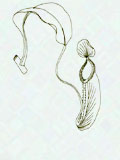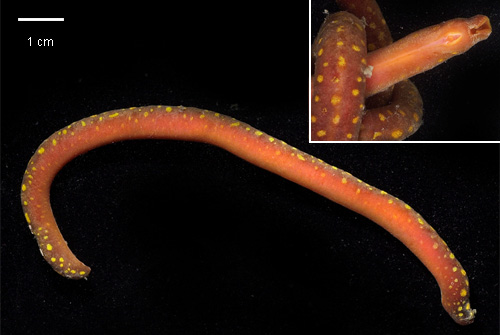

 |
 |
Invertebrates
| Scale insects on wild fruits | |
| Where are Hong Kong's forest ants? | |
| A deep dark discovery |
A deep dark discovery
by Brian DarvellFaculty of Dentistry
Snails come in a wide variety of shapes and sizes and have occupied many niches: grazer, scavenger, hunter; terrestrial, ocean surface to burrowing; free, commensal, parasitic; mobile and immobile; shelled and unshelled - most impressively the nudibranchs. However, the animal I collected some years ago was not recognizable to me as a snail: about 100 mm long, 6 mm across and worm-like, dark red with yellow spots. Not exactly lively, and I could find nothing at all in the picture books to identify it. Brian Morton knew what it was - a Solenogaster, an aplacophoran (no shell) mollusc. Apparently, it was thought to be a gorgonian mimic, living in sea-fans, but this was found on an overgrown rock with no fan in sight. Some years later, at Waterwitch Rock, Mirs Bay, I found another pair in a similar situation at about 18 m – again, no fans, but the appearance was strikingly like a sponge. Is that what they mimic?
So, they are not a well-known group to divers or field guide-compilers, and apparently quite uncommon: 3 in twenty years is not exactly a superabundance. True, they might be fairly cryptic, but I am used to crawling about on hands and knees, looking closely . . . which is how I found rather a lot more in early April this year. Off the north shore of Beaufort Island, where it is always pitch black, subject to strong currents and very low visibility (not a novice dive, by any means), between 13 and 23 m (at least) there were hundreds! Same species, in groups of 2s and 3s - even a dozen in an interwined mass, in clusters on some rocks, none on others. All were associated with a bright orange soft coral (which is abundant there), with some actively feeding by engulfing the unexpanded branches, swelling the head end to twice the usual diameter. There must have been a minimum of about 5 per square metre over a wide area, although the distribution was very clumpy - evidently a gregarious little beast.
Back in a tank, individuals in a small group did not show a great deal of activity, but occasionally one would rear up slowly, searching. There is a barely detectable groove along the belly - the pedal groove, and it seems that they are supposed to move by ciliary action of the small foot along a mucous strand secreted within the pedal groove; the foot remaining within the groove. What was observed, however, was slightly different: immediately under the head, the groove would be opened and the inner surfaces would be pressed to the tank wall to adhere quite firmly. This would then move over the surface, but the rest of the groove remained closed.
New records for Hong Kong? Probably. But a good example of how amateur sports divers can make useful observations underwater: the accumulated time, variety of sites dived and general enthusiasm can be harnessed to augment the professionals' scope. Now, is there a second species to be found...?
 |
|
Epimenia (?) sp. |
|
|
P.7 |
|
Porcupine! |
 Copyright © 2000 |